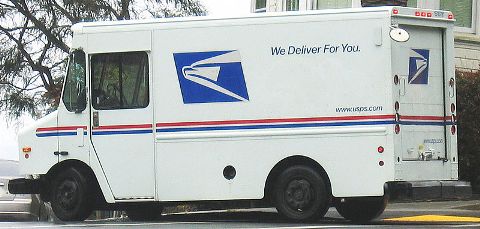by Dann Silverman
There has been a lot of talk about the future of the U.S. Postal Service (USPS). An American institution since the birth of  this country in 1775, when its first Postmaster General Benjamin Franklin led it, the USPS has fallen on hard times recently. In the 2013 fiscal year, the USPS lost $5 billion. Plans by the USPS to close some of its rural post offices and eliminate Saturday delivery have met resistance from members of Congress, even though the recent omnibus budget bill passed in the U.S. House of Representatives includes no new money for the service to halt further losses.
this country in 1775, when its first Postmaster General Benjamin Franklin led it, the USPS has fallen on hard times recently. In the 2013 fiscal year, the USPS lost $5 billion. Plans by the USPS to close some of its rural post offices and eliminate Saturday delivery have met resistance from members of Congress, even though the recent omnibus budget bill passed in the U.S. House of Representatives includes no new money for the service to halt further losses.
Customer skepticism and mistrust of the USPS’s ability to deliver mail on time and to the right location consistently, especially during busy periods like the holidays, have given rise to fierce competition from United Parcel Service (UPS) and FedEx. Part of the problem for the USPS is the way it is set up and run. Blanket restrictions on the USPS compromise the service’s ability to handle mail efficiently, which may ultimately make it obsolete.
Common Customer Problems with USPS
Some of the most common complaints lodged against the USPS include a longer than expected transit time for mail, items being lost, and damages to delivered items. These types of complaints have plagued the service for some time and have contributed to the overall mistrust and dissatisfaction postal customers have with USPS.
Are There Ways to Improve the Mail System?
Improving the efficiencies in the U.S. mail system may be difficult based on the USPS’s current business model. For over 140 years the USPS was a direct agency of the federal government, and the Postmaster General served as a cabinet level officer. The 1971 change in the Postmaster General’s role gave the service a unique opportunity to operate as both a federal protectorate and quasi-private enterprise. The change was meant to make USPS self-sufficient, but instead, the postal service has lost money in 16 of the last 18 quarters.
Improvements may happen if Congress were to completely privatize USPS. If not privatize, they must make appropriations necessary for the 490,000-employee organization to stem its losses and make the necessary technological investments for USPS to remain competitive.
Can USPS Meet the Challenges Posed by Competitors?
The postal union has been up in arms as of late over a plan approved in November 2013 between the USPS and office supply giants Office Depot and Staples to deliver packages for Amazon.com on Sundays. Deals like the one USPS has made with the office supply chains signals a recognition on their part that their current mode of operation will not allow it to keep pace with private delivery systems.
Reliance on traditional mail delivery services has waned in the US, and the service generally only handles items that cannot be delivered electronically, such as bulk packages. Email, SMS text, and other electronic means have made traditional letters obsolete, and a 239-year-old organization may be too old to change.
About the Author
Dann Silverman is a relaxation techniques instructor with an interest in social issues and movements. If you’re a business looking for a reliable way to get things to the right places, Dann recommends Reefer Trucking companies.


